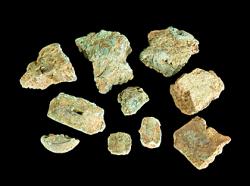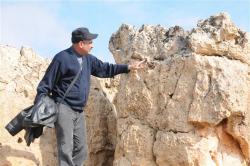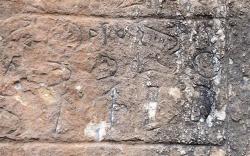INSTITUT SUPERIEUR D'ANTHROPOLOGIE
INSTITUTE OF ANTHROPOLOGY
ONLINE COURSES / COURS A DISTANCE
WINTER TERM : JANUARY 2015
REGISTER NOW
EGYPTE – Louxor - Spanish archeologists have unearthed a 3,600-year-old mummy in the ancient city of Luxor, Egypt's Antiquities Minister said Thursday. In a statement, Mohammed Ibrahim said the rare find in a preserved wooden sarcophagus dates back to 1600 BC, when the Pharaonic 17th Dynasty reigned. He said the mummy appears to belong to a high official. The sarcophagus is engraved with hieroglyphs and decorated with inscriptions of birds' feathers. The exact identity of the well-preserved mummy will now be studied
http://www.foxnews.com/science/2014/02/14/egypt-archaeologists-find-3600-year-old-mummy/?
ROYAUME UNI –  Dun Deardail - A three-year project to excavate an uninvestigated ancient hill fort close to Ben Nevis is due to start next year. Dun Deardail sits high on a rocky knoll on the west side of Glen Nevis in Lochaber and offers breathtaking views over the surrounding landscape. No archaeological excavation has ever taken place within the fort and it remains undated. However, digs at other similar sites indicate it may have been built and occupied – perhaps over several periods – between 700BC and 900AD. The fort also provides a nationally rare and important example of vitrification – a process by which intense heat from a man-made fire causes the smaller core material within the wall to partially melt and fuse.
Dun Deardail - A three-year project to excavate an uninvestigated ancient hill fort close to Ben Nevis is due to start next year. Dun Deardail sits high on a rocky knoll on the west side of Glen Nevis in Lochaber and offers breathtaking views over the surrounding landscape. No archaeological excavation has ever taken place within the fort and it remains undated. However, digs at other similar sites indicate it may have been built and occupied – perhaps over several periods – between 700BC and 900AD. The fort also provides a nationally rare and important example of vitrification – a process by which intense heat from a man-made fire causes the smaller core material within the wall to partially melt and fuse.
https://www.pressandjournal.co.uk/fp/news/highlands/437697/new-project-will-reveal-history-of-ancient-hill-fort-near-ben-nevis/
ROYAUME UNI –  Marloes and St Brides - Archaeologists investigating a 2.5-kilogram hoard of sword blades, scabbards and knives found by a metal detectorist in January 2013 say the plough-disturbed artefacts could have been delivered to Wales by sea from southern England or northern France.Two blade fragments, a scabbard fitting, a multi-edged knife and six copper ingot fragments were discovered by Adrian Young a few metres apart from each other in the corner of a field in Marloes and St Brides .The Coroner for Pembrokeshire has now officially declared the hoard treasure, with archaeologists at National Museum Wales dating it to between 2,800 and 3,000 years ago.“The combination of objects found in this hoard hints at the long-distance sea travel of finished objects during the Late Bronze Age, from southern England and northern France to west Wales,” says Adam Gwilt, the Principal Curator for Prehistory at National Museum Wales.“The swords, scabbard and knife are exotic types, not typical for the region.“We can now see that copper ingot fragments are common components within hoards from Pembrokeshire, similar to a pattern also seen in Cornwall.”
Marloes and St Brides - Archaeologists investigating a 2.5-kilogram hoard of sword blades, scabbards and knives found by a metal detectorist in January 2013 say the plough-disturbed artefacts could have been delivered to Wales by sea from southern England or northern France.Two blade fragments, a scabbard fitting, a multi-edged knife and six copper ingot fragments were discovered by Adrian Young a few metres apart from each other in the corner of a field in Marloes and St Brides .The Coroner for Pembrokeshire has now officially declared the hoard treasure, with archaeologists at National Museum Wales dating it to between 2,800 and 3,000 years ago.“The combination of objects found in this hoard hints at the long-distance sea travel of finished objects during the Late Bronze Age, from southern England and northern France to west Wales,” says Adam Gwilt, the Principal Curator for Prehistory at National Museum Wales.“The swords, scabbard and knife are exotic types, not typical for the region.“We can now see that copper ingot fragments are common components within hoards from Pembrokeshire, similar to a pattern also seen in Cornwall.”
http://www.culture24.org.uk/history-and-heritage/archaeology/art511370-exotic-hoard-artefacts-found-in-field-hint-at-long-distance-bronze-age-sea-travel-say-archaeologists-in-wales
TURQUIE –  Salkımlı -The ceramic pieces and city walls that were unearthed during the works on Salkımlı village road in the southeastern province of Batman have been discovered to be from the medieval ages. Dicle University Ziya Gökalp Faculty academic Associated Professor Sabri Karadağ said they had performed a surface survey in the region and found the pieces some time ago. “This place is like a medieval castle. There are stone steps, walls and residences at the top of the walls. We have many settlements like this in the Dicle Valley. We can say that this place is a settlement from the Middle Ages and was established with the purpose of protection,” he said. Karadağ said the outskirts of the Dicle Valley were home to many inns, as well as remains of the Neolithic age. Life continued in the inn in the Salkımlı village, he said, and continued: “Behind is Çayüstü village; people are still living in the inns there, too. Life has been continuing in Dicle since 12,000 B.C. The Dicle Valley could become a national park. It should be for the sake of the Turkish economy. People prefer cultural heritage and geological structures rather than the sea, sun and sand. The valley has all of it.”
Salkımlı -The ceramic pieces and city walls that were unearthed during the works on Salkımlı village road in the southeastern province of Batman have been discovered to be from the medieval ages. Dicle University Ziya Gökalp Faculty academic Associated Professor Sabri Karadağ said they had performed a surface survey in the region and found the pieces some time ago. “This place is like a medieval castle. There are stone steps, walls and residences at the top of the walls. We have many settlements like this in the Dicle Valley. We can say that this place is a settlement from the Middle Ages and was established with the purpose of protection,” he said. Karadağ said the outskirts of the Dicle Valley were home to many inns, as well as remains of the Neolithic age. Life continued in the inn in the Salkımlı village, he said, and continued: “Behind is Çayüstü village; people are still living in the inns there, too. Life has been continuing in Dicle since 12,000 B.C. The Dicle Valley could become a national park. It should be for the sake of the Turkish economy. People prefer cultural heritage and geological structures rather than the sea, sun and sand. The valley has all of it.”
http://www.hurriyetdailynews.com/batmans-castle-from-medieval-ages.aspx?PageID=238&NID=75981&NewsCatID=375
PAKISTAN – Bhamala - Archaeologists have discovered Buddhist sculptures and coins dating back to the 2nd to 5th centuries during ongoing excavation at the site of an ancient Buddhist Stupa in northwest Pakistan. Director of Archaeology and Museums, Khyber Pakhtunkhwa, Abdul Samad said that sculptures and heads dating from 2nd to 5th centuries have been discovered during excavation, initiated at the Bhamala Buddhist complex. During excavation, precious coins of Kushan period were also unearthed around the Stupa. Bhamala archaeological site has ruins of the Buddhist Stupa, declared as a National and World Heritage Site, located near Khanpur dam in Haripur. The ruins date back to the 4th century CE. Samad said that during the excavation, mostly terracotta sculptures have been discovered. He said archaeologists, conservators, diggers, and treasury hunters took part the in excavation at Bhamala.
http://economictimes.indiatimes.com/news/international/world-news/buddhist-sculptures-kushan-era-coins-found-at-pakistan-site/articleshow/45652157.cms
TURQUIE –  Bolkar Mountains - A 2,800-year-old Hittite inscription, which is on a rock in the Bolkar Mountain in the Central Anatolian province of Niğde and claimed to be the world’s oldest mining license, will be taken under protection. Niğde Culture and Tourism Director Tansel Tokmak said the 108-centimeter high and 186-centimeter wide inscription was from the late Hittite period, adding, “This region is rich in terms of the abundance of mineral. The inscription, which is estimated to have been written in the 8th century, is known as the first mining license in history. The first scientific work on the inscription was made by Professor Mustafa Kalaç in 1973. He said measures should be taken to protect it. In 2013, museum archaeologists examined the piece and said 8 percent of the inscription had been damaged.” Tokmak said they had initiated worked to take the necessary measures for the protection of the inscription. “It will be taken under protection. In the next level, the inscription will be copied and exhibited at the Niğde Museum as the ‘Bolkar Mine Inscription,’” he said. Niğde Museum Directorate archaeologist Mustafa Eryaman said mining activities in the region dated back to 2,800 years ago, and continued in the Roman, Byzantium, Seljuk, Ottoman and Republican eras. “The inscription, translated by Kalaç, writes that King Warpalavas gave the administration of the Bolkar Mountains to Prince Tarhunzas and wishes for the mountain to be productive,” said Tokmak.
Bolkar Mountains - A 2,800-year-old Hittite inscription, which is on a rock in the Bolkar Mountain in the Central Anatolian province of Niğde and claimed to be the world’s oldest mining license, will be taken under protection. Niğde Culture and Tourism Director Tansel Tokmak said the 108-centimeter high and 186-centimeter wide inscription was from the late Hittite period, adding, “This region is rich in terms of the abundance of mineral. The inscription, which is estimated to have been written in the 8th century, is known as the first mining license in history. The first scientific work on the inscription was made by Professor Mustafa Kalaç in 1973. He said measures should be taken to protect it. In 2013, museum archaeologists examined the piece and said 8 percent of the inscription had been damaged.” Tokmak said they had initiated worked to take the necessary measures for the protection of the inscription. “It will be taken under protection. In the next level, the inscription will be copied and exhibited at the Niğde Museum as the ‘Bolkar Mine Inscription,’” he said. Niğde Museum Directorate archaeologist Mustafa Eryaman said mining activities in the region dated back to 2,800 years ago, and continued in the Roman, Byzantium, Seljuk, Ottoman and Republican eras. “The inscription, translated by Kalaç, writes that King Warpalavas gave the administration of the Bolkar Mountains to Prince Tarhunzas and wishes for the mountain to be productive,” said Tokmak.
http://www.hurriyetdailynews.com/hittite-rock-inscription-in-bolkar-mountain-to-be-taken-under-protection.aspx?pageID=238&nID=76045&NewsCatID=375
TURQUIE-  Mardin - Archaeological works have been accelerated on the Mardin Castle, known as the “Eagle Nest,” with a trained restoration team working on preventing stones and rocks from falling on the houses and historic structures in the outskirts of the castle. The castle was partly restored at the time of Ottoman Sultan Selim III and was taken under restoration again after many years. The castle is 1200 meters above sea level and 600 meters above ground. It is the highest point overlooking the old town of Mardin, which rises out of the side of a hill. Mardin has witnessed the Assyrian, Persian, Roman, Byzantium, Umayyad, Abbasid, Seljuk, Hamdani, Artuklu, Karakoyunlu, Akkoyunlu, Safevi and Ottoman eras, without ever losing its importance. According to history, King Şad Buhari, a Zorastrian, arrived in Mardin Castle in 330 A.D. The ill King had a summer-place built and lived in Mardin for 12 years. Because he recovered during his stay in the castle, he brought many soldiers and civilians from his country, Persia, to relocate them in Mardin. Many improvements were seen after their arrival until 442 A.D. In 442 A.D. a terrible plague epidemic made the city an intolerable place to live.
Mardin - Archaeological works have been accelerated on the Mardin Castle, known as the “Eagle Nest,” with a trained restoration team working on preventing stones and rocks from falling on the houses and historic structures in the outskirts of the castle. The castle was partly restored at the time of Ottoman Sultan Selim III and was taken under restoration again after many years. The castle is 1200 meters above sea level and 600 meters above ground. It is the highest point overlooking the old town of Mardin, which rises out of the side of a hill. Mardin has witnessed the Assyrian, Persian, Roman, Byzantium, Umayyad, Abbasid, Seljuk, Hamdani, Artuklu, Karakoyunlu, Akkoyunlu, Safevi and Ottoman eras, without ever losing its importance. According to history, King Şad Buhari, a Zorastrian, arrived in Mardin Castle in 330 A.D. The ill King had a summer-place built and lived in Mardin for 12 years. Because he recovered during his stay in the castle, he brought many soldiers and civilians from his country, Persia, to relocate them in Mardin. Many improvements were seen after their arrival until 442 A.D. In 442 A.D. a terrible plague epidemic made the city an intolerable place to live.
http://www.hurriyetdailynews.com/mardin-castle-restored-by-climbers.aspx?PageID=238&NID=76046&NewsCatID=375
VIET NAM - Bai Soi mound - The vestiges of a 3,500-year-old village have been discovered in the northern province of Tuyen Quang and considered part of a thriving ancient culture. Vietnamplus – a member of the Vietnam News Agency – on Tuesday cited Associate Professor Trinh Nang Chung, of the Institute of Archeology, as saying that archeologists have found a 10,000m² ruin on Bai Soi mound. Located along the banks of the Pho Day River in Son Duong District, the ruin belongs to Phung Nguyen Culture, which is an early Bronze Age civilization dating back around 3,500-4,000 years ago, according to Associate Professor Chung. The ruins of the civilization are believed to be first unearthed in the northern province of Phu Tho, and later in Hanoi, Hai Phong City and several other northern provinces. The civilization was of immense cultural importance to the establishment of Vietnam in its early days, Associate Professor Chung said. The latest excavation uncovered over 400 artifacts, mostly pottery fragments, stone household and production tools, and a small number of bones, the archeologist added. The pottery broken items feature diverse patterns. The findings, including a rarely found pebble, shed more light on Phung Nguyen Culture and its origin. Though human remains were not found in this excavation, the two newly-discovered large holes and a ceramic pot are suggestive of tombs, Associate Professor Chung noted.
http://tuoitrenews.vn/lifestyle/24937/millenniaold-village-unearthed-in-northern-vietnam